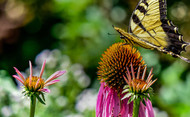Pollinator gardens have been in the news these last few years. Most of the articles focus on monarch butterflies and planting milkweed to support them. But they can be so much more than this and can help so many more living things than just monarchs.
What is a pollinator garden and why have one?
On some level, it is simply a garden with plants that supports insects with food and shelter. On the larger level, pollinator gardens are part of the massive food web that is our environment. Everything is interconnected. While milkweed supplies food for the monarch caterpillars, the flowers attract wasps, bees, and flies. These insects in turn become food for birds and small mammals to feed their young. The birds and small mammals are part of the food chain for hawks and foxes. In the fall, the seeds become food for birds and small mammals, and the hollow stems and dead leaves become homes to solitary bees and beneficial bugs to overwinter in. A pollinator garden should not be ‘cleaned up’ until late spring, or you will be throwing out the bees, butterflies and moths that hibernate there. To help them even further, you can also add some man made homes for the bees and the butterflies. Remember to clean out the boxes every year in the spring, once it warms up, to avoid transmitting any disease from year to year.



